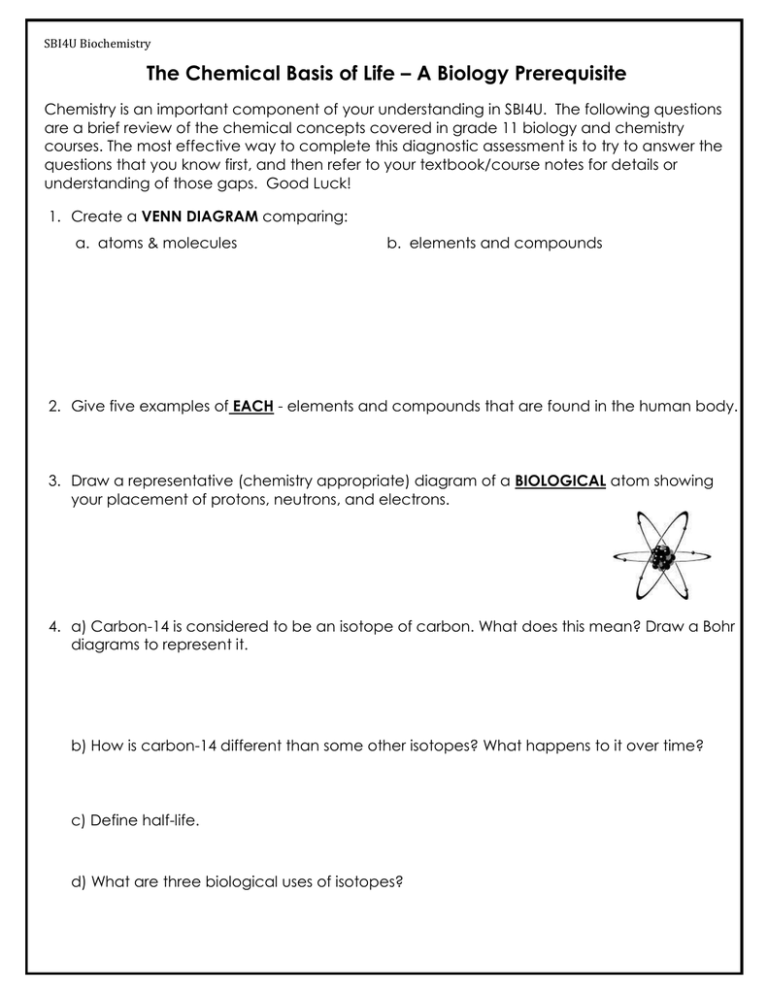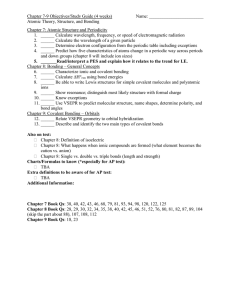The Chemical Basis of Life – A Biology Prerequisite
advertisement

SBI4U Biochemistry The Chemical Basis of Life – A Biology Prerequisite Chemistry is an important component of your understanding in SBI4U. The following questions are a brief review of the chemical concepts covered in grade 11 biology and chemistry courses. The most effective way to complete this diagnostic assessment is to try to answer the questions that you know first, and then refer to your textbook/course notes for details or understanding of those gaps. Good Luck! 1. Create a VENN DIAGRAM comparing: a. atoms & molecules b. elements and compounds 2. Give five examples of EACH - elements and compounds that are found in the human body. 3. Draw a representative (chemistry appropriate) diagram of a BIOLOGICAL atom showing your placement of protons, neutrons, and electrons. 4. a) Carbon-14 is considered to be an isotope of carbon. What does this mean? Draw a Bohr diagrams to represent it. b) How is carbon-14 different than some other isotopes? What happens to it over time? c) Define half-life. d) What are three biological uses of isotopes? SBI4U Biochemistry 5. Distinguish between an energy level and an orbital? What is an orbital’s maximum capacity? 6. What are valence electrons? Why are they particularly of interest to scientists? 7. Show a biological element with a Lewis dot diagram. 8. a) What is meant when we say an atom is neutral? b) What is an ion? Describe its electron arrangement. c) Differentiate between a cation and anion. d) Give 5 examples of ions found in the human body. 9. a) Create a small CONCEPT MAP on a separate piece of paper illustrating your current understanding of chemical bonding. Start with the following terms in your parking lot and then add additional ones as you deem fit. ionic bonding polar covalent compounds electron sharing electronegativity covalent bonding attractive force metal electron transfer valence electrons pure covalent elements non-metal ions stable octet For those with grade 12 chemistry in your back pocket, include the use of: intermolecular force intramolecular force hydrogen bonding London force Dipole-dipole force hydrophobic interaction SBI4U Biochemistry b) Why is chemical bonding an important term for biologists to understand? 10. State the type of bonding that is taking place (pure covalent, polar covalent, ionic) in the following particles. Visually demonstrate the bonding by using an appropriate bonding diagram. a) O2 c) NaCl b) H2O d) CH4 11. What happens to orbitals of different atoms during bonding? Why is this significant with respect to the molecule? 12. What does it mean if a molecule is polar? 13. How can a molecule have polar covalent bonds but be classified as non-polar? 14. Why would polarity be an important idea for biologists to understand? 15. Differentiate between an intermolecular and intramolecular force. Give an example of each. SBI4U Biochemistry 16. a) Differentiate between an acid and base. b) What does pH mean? c) Draw and label the pH scale demonstrating where the acids would be found, and where the bases would be found. d) What is the approximate pH of your stomach? blood? small intestine? e) What is a hydronium ion? Why is it technically incorrect to call a hydronium ion a hydrogen ion? f) What is it called when an acid is added to a base in equal proportions? Provide a sample equation. Identify the products. g) What is the difference between a strong acid and a weak acid?



